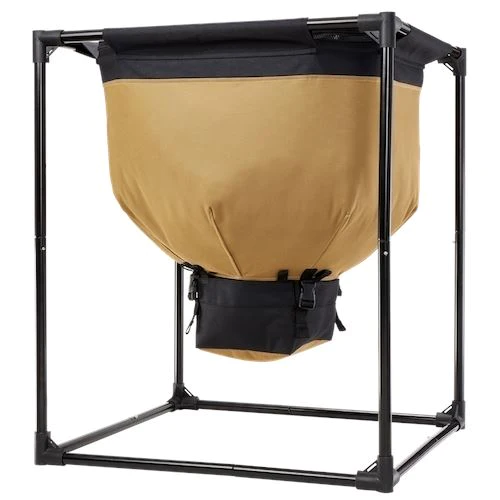The African nightcrawler or Eudrilus euginae is one of the most popular earthworms for composting. It is native to South Africa but common globally, especially in warm and sub-tropical regions. They are known for their quick reproduction rate, making them easy to grow. Plus, the growing requirements are minimal, with the most important being the right temperature.
If you intend to grow African nightcrawlers at home, keep on reading. We’ll talk about some of the best things that you can do. Aside from composting, raising this worm is also a good idea if you are a fishing enthusiast. It will make an exceptional choice for live fishing bait!
Physical Characteristics
For the untrained eye, it is difficult to identify an African nightcrawler. It looks like almost all earthworms.
On average, the length of African nightcrawlers is 6 to 12 inches when they are mature. They can even be larger! The length is comparable to European and Canadian nightcrawlers. The main difference, however, is that the African nightcrawler is smaller in terms of diameter.
One of the easiest ways to identify and differentiate the African nightcrawler is to look closely at its body. You will notice that it has a raised saddle or clitellum, which will remind you of a red wiggler. It will also have a visible banding when the worm stretches. In terms of color, the top is purple to dark red. There is an iridescent sheen when it catches the sunlight. The lower part of the worm, on the other hand, is grey or pink.
In the soil, the African nightcrawler is a fast mover. On the other hand, when it is held in your hand, you will notice that the worm is significantly slower.
These worms are known for being copious providers of worm castings. They generate a large amount of body waste that can enrich soil quality, making it more suitable for crop production.
How to Feed African Nightcrawlers
Being voracious eaters, make sure that African nightcrawlers receive enough food. The amount of food to provide these worms will depend on how many pounds you have in a bin.
What to Feed
The best scraps to feed African nightcrawlers include fruit waste, such as apples, bananas, pears, and peaches. Make sure to not give them citrus fruits. For vegetable waste, some of the best options are carrots, peas, beans, and lettuce, among others. Coffee grounds are also great, but make sure to provide them in moderation. You can also feed eggshells, but make sure that you crush them. You can also feed them with grass clippings and yard debris. Shredded cardboard is also an excellent choice. Even better, it can also double as bedding. This helps in absorbing water and moisture to prevent the soil from soaking.
What Not to Feed
While they eat a lot, you also need to know what to avoid. As mentioned, citrus fruits are not for them. You should also avoid fish and meat. They can leave a foul smell in the composting bin. Human and pet waste are also prohibited. You should also avoid feedstock with grease and oils since they can suffocate the worms.
Reproduction
With the quick reproduction rate of nightcrawlers, you do not need to wait a long time before they are ready for harvest. You can use it as a fishing bait shortly after starting the breeding process. With their very fast reproduction rate, you can expect two to three cocoons every week. Meanwhile, in every cocoon, there are two to three babies. Each worm can produce six to seven new worms in a week, provided that you have the right growing conditions.
Raising African Night Crawlers
If you intend to raise African nightcrawlers, one of the first things that you need to do is to create a worm bin. If that’s the case, then take note of the steps briefly mentioned below:
- The first thing to do is to find a suitable container. Make sure that it is deep enough to accommodate soil and worm. The size will depend on how many worms you wish to raise.
- Once the containers are ready, drill holes. You will need generous aeration. This will prevent the soil from soaking.
- Add a layer of shredded paper or cardboard at the bottom. Next, add your choice of soil. Pick a well-balanced soil to help succeed in your endeavor.
- Add the worms to the top of the soil. Add a thin layer of soil to cover the worms. To finish, sprinkle food scraps on the top so that worms will have something to feed on.

4-PACK URBAN WORM BAG VERSION 2
Create organic fertilizer inside or outside your home or apartment using nothing more than common household waste like newsprint, cardboard, and food waste.
Aside from the proper set-up of the worm bin, here are other tips and tricks that can help in raising African nightcrawlers:
- Avoid over-crowding. See to it that there is enough room for the worms to move. Otherwise, they will die.
- At least twice a week, take the time to check the moisture level of the worm bin as this is a crucial factor for survival. Squeeze the soil lightly with your fist. There should be a clump. Otherwise, this is an indication that water is needed. Sprinkle water on the top instead of pouring. Do not add more than what is necessary.
- Keep an eye on the potential pests. The best way to avoid their presence in the worm bin is to be mindful of the food scraps that you are using. As soon as you see a pest, take it out and note the source so that you can prevent adding the same food.
- Use your nose to determine the condition of the bin. If it smells off, then this is a sign that there is something wrong. It can be a symptom of pest infestation. It may also mean that the worm bin is too dry or too moist.
Breeding
African nightcrawlers are notable because they breed quickly. The breeding is faster compared to European and African nightcrawlers. It is best to keep them indoors when breeding, especially during the cold season. While they can tolerate near-freezing temperatures, the breeding stops at about 50 degrees Fahrenheit.
Frequently Asked Questions
Before we end this guide, let’s answer a few questions you might have about African nightcrawlers.
What are the benefits of raising African nightcrawlers?
Raising African nightcrawlers is beneficial if you want to try composting at home. This is also a good idea for those who would like to raise their bait. Plus, it has benefits for the soil. It can improve soil structure and aeration, making it healthier for plants. Not to mention, it will be effective in breaking down organic waste. More so, the castings can act as natural fertilizers.
What are the temperature requirements of African nightcrawlers?
In most cases, they can survive in temperatures ranging from 38 to 85 degrees Fahrenheit. Nonetheless, take note that they can hardly survive when it is extremely cold. When the temperature drops, you might want to consider bringing the worms indoors or covering the bin to provide the insulation that they need.
How do you harvest African nightcrawlers?
When it is time to harvest worm castings, which you can use in the garden, below are some of the most popular methods.
Top Harvesting: The easiest method, requires waiting for a thick layer of vermicast to form at the top of the soil. Sweep the casting and use your hand to scoop them out of the bin. Be gentle to avoid accidentally crushing the worms.
Dry and Sift: This method requires drying the bin by as much as 40%. When moisture is at a minimum, sift to harvest.
Migration: This method of harvesting relies on the ability of African nightcrawlers to follow food. You can add food to where you want the worms to go, add a screen or any platform where worms crawl, and wait for them to move out of the bin. Once they are out, all that will be left in the bin would be the worm castings that you need.
How do I compost in the winter?
While low temperatures can kill African nightcrawlers, in many instances, they can manage to survive in the winter. The technique here is to provide proper insulation. Adding mulch and hay to the soil will help. They will function as natural insulation. Covering the top of the bin can also help to shield the worms from freezing temperatures. More so, you need to bring the worm bin indoors.
What is a fishing worm?
A fishing worm, also known as a bait worm, is a type of worm species that is commonly used as bait in fishing. One popular species of fishing worm is the “eudrilus eugeniae”.
What is the “eudrilus eugeniae” worm?
The “eudrilus eugeniae” worm, commonly known as the African nightcrawler or ANC, is a type of worm species that is well-known for its size, averaging several inches in length. It has a uniform purple-grey color and is often used for composting and as bait worms in fishing.
Are there other types of nightcrawlers besides the African nightcrawler?
Yes, besides the African nightcrawler, there are other types of nightcrawlers. One example is the European nightcrawler, also known as the “European nightcrawlers”. It is a larger composting worm that can tolerate higher temperatures than its composting cousins.
Is the African nightcrawler also suitable for composting?
Yes, the African nightcrawler is known for its size and appetite for organic matter, making it an excellent worm species for composting.
Are there any other worm species that can tolerate higher temperatures?
Yes, besides the African nightcrawler, the tropical worm species is another type of worm that can tolerate higher temperatures than its composting cousins. It is often used for composting purposes.
Where can I buy African nightcrawlers or other types of worms?
You can buy African nightcrawlers, European nightcrawlers, and other worm species from reputable worm suppliers or online stores that specialize in worm sales.
What are the benefits of using nightcrawlers for composting?
Nightcrawlers, such as the African nightcrawler and European nightcrawler, are excellent for composting because they help break down organic matter, speed up the decomposition process, and enrich the compost with their nutrient-rich castings.
Are nightcrawlers good for fishing?
Yes, nightcrawlers, including the African nightcrawler and European nightcrawler, are highly regarded as excellent bait worms for fishing due to their size and appetite, which attract fish.
What is the largest composting worm?
The African nightcrawler is known as one of the largest composting worms, often growing several inches in length.
Is the “European nightcrawlers” another term for the African nightcrawler?
No, the European nightcrawler is not another term for the African nightcrawler. While both are types of earthworms commonly used for vermicomposting, they are different species. The European nightcrawler (Eisenia hortensis) is native to Europe, while the African nightcrawler (Eudrilus eugeniae) is native to tropical regions of Africa. They have some differences in size, behavior, and preferred environmental conditions.
Conclusion
The African Nightcrawler, scientifically recognized and often referred to as the “ANC”, has distinct characteristics that make it quickly stand out amongst other worms. With its unique uniform purple-grey sheen and the posterior segments that are evenly tapered to a point, it’s no wonder this worm species is quickly becoming the most sought-after by composters and anglers alike. When compared to the Midwest worms and the Canadian nightcrawler, the ANC’s distinguishable purple-grey hue is unmatched. Moreover, these worms can grow to an impressive length, with some reaching 6-8 inches long, making them twice the size of the red worms commonly found in composting.
Their size, combined with their resilience, makes them exceptional for various purposes. The tropical worm species tolerates higher temperatures, giving them an advantage in warmer climates. Their capacity to consume large amounts of organic material – the larger the worm, the greater its appetite – is particularly noteworthy. These earthworms can consume their body weight each day, making them exceptional composters, ideal for converting waste into rich vermicompost. Furthermore, they produce worm castings that are beneficial for soil enrichment.
For those who want to produce a maximum yield in vermicomposting, the African Nightcrawler’s ability to breed quickly is another advantage. Under ideal conditions, they can lay multiple cocoons per week. Beyond composting, the ANC’s length and the characteristic purple-grey sheen on its posterior segments make it a fantastic fishing worm. This attribute means they’re not only useful for composting but also good fishing bait, a dual-purpose not often found in many worms.
In summary, whether one is into composting or fishing, the African Nightcrawler, with its diverse attributes from its grey and purple hue to its voracious appetite, is becoming a favorite. It is clear that the earthworm is prized for its benefits in both the gardening and fishing communities. Given its advantages, it seems the African Nightcrawler is poised to remain a prominent figure in both the composting and fishing worlds for the foreseeable future.







